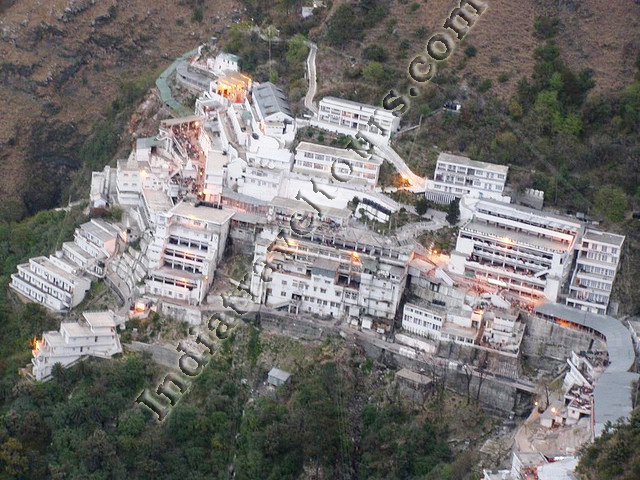Vaishno Devi Temple | India Tourist Spots | Places to Visit in India
A pilgrimage to the Holy Shrine of Shri Mata Vaishno Devi is considered to be one of the holiest pilgrimages among Hindus. Shri Mata Vaishno Devi inhabits the Holy Cave at an altitude of 5200 ft which is located in the furrow of the three peaked mountain namedTrikoot. The devotees have to trek 14.5 km from the base camp at Katra, near Jammu in J & K. The Mother Goddess reveals herself in a five and a half feet tall rock having three heads (Pindies) at its top in this Holy Cave. Devotees worship these three heads orHoly Pindiesconsidering them to be the revelation of the Mother Goddess. This whole rock is submerged in water, and devotees pay their obeisance atop the surrounding marble platform constructed for this purpose.
The threeHoly Pindiesmanifest the Divine Mother asMaha Kali, at the right hand representing the Tam Guna – the quality associated with the darker and unknown realms of life, indicating the sub-conscious state of mind. The central Pindi revered asMaha Lakshmi is said tosymbolize Rajas Guna – which characterises motivation and all endeavour. She is deemed to be the vital source of all affluence, opulence, material gains, excellence of life etc. The left Pindi is venerated as theMaha Saraswati who is regarded as the fountainhead of all creation, learning, wisdom, virtue, fine arts, spiritualism, and piety etc. She embodies the Satva Guna – the characteristic purity. One trek from Vaishno Devi temple leads to Baba Bhairon nath (1.5 km). It is generally believed that the Vaishno Devi pilgrimage is not accomplished till one visits the Bhairon nath temple.
One very important feature of this temple is that the deity is accessible all through the year, round the clock, without any off hours. Devotees popularly believe that the Divine Mother herself sends an invitation to her children, in some form, maybe communicated through an intuition. The moment this invitation is received, the devotee is bound to honour it on his/her own free volition, to receive her unbounded love and blessings.
History
This widely revered temple of the Mother Goddess finds first mention in the legendary epic Mahabharat. When the armies of Pandavs and Kauravs were arrayed in the battlefield of Kurukshetra, Arjun, the chief warrior of Pandavs meditated upon the Mother Goddess upon advice of Sri Krishna and sought her blessings for victory. In this episode, the celebrated warrior invokes the Mother Goddess as Jambookatak Chityaishu Nityam Sannihitalaye which translates to you who forever resides in your abode adjacent to the mountain in Jamboo (possibly referring to the present day Jammu).
It is generally believed that the Pandavs were the first to build the temples in reverence and gratitude for the Mother Goddess after their victory. Interestingly, there are five stone structures on a mountain close to the Trikoot Mountain, which apparently observe the Holy Cave. Devotees believe that these are the rock symbols of the five Pandavs.
Perhaps the oldest reference of the visit of a historical figure to the Holy Cave is that of Guru Gobind Singh who is said to have gone there via Purmandal.
Traditions believe this Shrine to be the holiest of all Shaktipeeths as the right arm of Sati had fallen at this spot, as one does find some stone remains of a human hand, popularly known as Varad Hast (the hand that grants boons and blessings).
As per prevalent legends, the discovery of Shrine around 700 years is attributed to one Pandit Sridhar, who was granted a vision (dream) in which Mata Vaishnavi told him to search for her at the Holy Cave situated amidst the folds of the Trikoot Mountain. On reaching this spot, he came across a rock structure in the cave with three heads atop it. At that moment Mata Vaishno Devi appeared before him in all her glory and blessed him with a boon of four sons and a right to worship her manifestation and asked him to spread the glory of the Holy Shrine all over.
Since the year 1986, when the Shri Mata Vaishno Devi Shrine Board (commonly called Shrine Board) was formed (under The Jammu & Kashmir Shri Mata Vaishno Devi Shrine Act, 1986), the management of the Shrine and regulation of the Yatra has been vested in the Board.
How to Reach Vaishno Devi
The Holy Cave of Shri Mata Vaishno Devi is located 14.5 kms from Katra town in Jammu & Kashmir via Ban Ganga Road. Katra town is 48.5 kms away to the north of Jammu Railway Station (J&K). Jammu being the winter capital of J&K is connected by air and through trains with all major towns in the country.
Relevance of Temple Darshan
This highly revered Shaktipeeth is one of the major Hindu shrines in north India. Devotees popularly believe that once invited, nobody can be bereft of her kind blessings, indicating that she fulfills all desires of her children.
In view of this innate belief, devotees throng to this temple in substantially increasing numbers. The gross attendance at this shrine exceeded 5 million last year. Not only from all corners of the country, the faithful come from all lands, from all over the globe.
